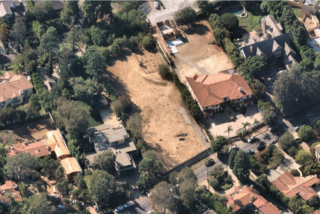When Passion and Substance Meet, a Tree Takes Root
- Share via
surely there exists some spindly branch of psychology that can explain why we so often get all worked up about piffle but ignore matters that could split the world asunder.
In e-mail screeds we unleash our passions about some second-string Dodger trade, or burn up the phone lines in a chin wag about the bed romps of a soap opera character, while matters of great import whiz past our heads like large-caliber shells: a Supreme Court decision that will shape the lives of progeny yet unimagined, a Pennsylvania Avenue pen flourish that means a thumbs-down for livelihoods.
Nobody ever gets into a bar fight over the meat-and-potatoes stuff, like whether to invest Social Security funds in the stock market (“Buddy, Ah’m tellin’ ya: One more crack about puttin’ mah gub’mint nest aig in Microsoft and Ah’ll crack this here longneck over yer haid.”)
Once in a while, passion and substance do meet up and take a spin around the cosmic dance floor. Trees, to my recurring surprise, we take seriously. Perhaps because our pagan forebears endowed them with spirits of their own, we can still muster a quaver about this environmental murder-suicide pact we’ve undertaken, and see in a tree an anchor to some earlier, earthier self. (Sprint, trying to persuade Manhattan Beach to let it set up a telecommunications tower, offered to disguise it as a tree.)
Few of Gov. Reagan’s remarks have been repeated so often as his “seen one redwood, seen ‘em all.” Up in the Headwaters Forest, whose old-growth redwoods have become the last stand in a war of environment and politics, a woman has lived for more than a year in a giant tree she has named Luna, in hopes that if she can save this one redwood, she can help to save them all.
*
Once upon a time, Los Angeles was lousy with trees. The cooler prehistoric climate coddled sequoias, pines and cedars.
The flora changed with the climate, and then with the cultivations of man. By this century, there were trees aplenty, all right--orange and lemon and walnut and olive, all in nice serried rows. Eventually they were blasted down like foot soldiers, to be replaced by serried rows of another cash crop, houses.
Every surviving urban and suburban tree represents a fight in the making.
The state sued four San Clemente men for dressing up in Caltrans orange and hacking down more than 50 eucalyptus trees that blocked their view after the trees were planted to block freeway noise. Trees get toppled because a city no longer has a budget to keep them. And some developers evidently practice the belief that it’s easier to cut first and pay the fine later.
Although oaks and vines cohabit happily in France, Kendall-Jackson Winery got itself in bad odor by ripping out 843 ancient California oaks a couple of years back; it made people so riled that they got up a ballot measure to protect native oak trees; it failed by a nose.
Dana Point homeowners were so shocked at wholesale eucalyptus cutting (a hedge against potential lawsuits over fallen branches, as if nature and gravity had a choice in the matter) that they barricaded the street to stop the chain saw massacre, and stop it did.
A Tarzana-based landscape firm, whose owner had already pleaded no contest to destroying the nest of a protected bird of prey, just got nailed after two workers supposedly killed one red-tailed hawk and injured another by cutting off a nest-bearing tree limb.
Yet it was also in Tarzana--named for the fictional hero of his creation--that Edgar Rice Burroughs thought highly enough of the place to have his ashes buried under a tree on the family property. And Tarzanans are now primed for combat with a developer who wants to raze nearly 300 rare, mature trees to build 30 houses.
Then there was the Lang Oak in Encino.
Seven stories tall, it was a thousand years in the growing--half a millennium old when Cortez came ashore in Mexico--and only three-quarters of a century a-dying after the newly built 1921 Encino Reservoir throttled its water supply. In the days after it toppled in a 1998 storm, cops had to stand guard: Its mourners kept trying to filch a splinter of history, just as the faithful of another age stealthily mopped up the blood of martyred saints.
*
If money did grow on trees, it would be easier to save them; as it is, their subtler cost benefits don’t do much to stay a profiteer’s ax. Yet no trees can mean no birds, no birds means more bugs and rodents. Oak trees in particular resist smog and drought, cooling whole neighborhoods and “sweating” gallons of humidifying moisture. A mature tree can scrub the air of as much as 25,000 car-miles worth of carbon pollution.
For all its manifold virtues, The Tree may only be worshiped again, talisman-fashion, when it becomes so rare that, like certain orchids and cacti, it must be guarded not against the wholesale hatchet man of yore but against the plant pirate, poaching a treasured specimen for some billionaire’s arboreal zoo.
*
Patt Morrison’s e-mail address is [email protected]



